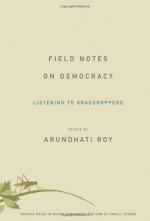|
This section contains 580 words (approx. 2 pages at 400 words per page) |

|
Field Notes on Democracy Summary & Study Guide Description
Field Notes on Democracy Summary & Study Guide includes comprehensive information and analysis to help you understand the book. This study guide contains the following sections:
This detailed literature summary also contains Topics for Discussion on Field Notes on Democracy by Arundhati Roy.
The following version of the book was used to create this study guide: Roy, Arundhati. Field Notes on Democracy: Listening to Grasshoppers. Haymarket Books, 2009.
Field Notes on Democracy: Listening to Grasshoppers is a collection of 12 fictional and non-fictional works by author Arundhati Roy, written and published previously between the years of 2002 and 2009. The introduction, titled “Democracy’s Failed Light,” frames the essays in terms of a flawed and failing democratic Indian state, which Roy views as increasingly fascist.
In the introduction, Roy criticizes Hindu nationalism, which has increased violence directed towards non-Hindus. As examples, she particularly draws upon the killing of roughly 2,000 Muslims in the state of Gujarat in 2002 and, more recently, the Indian state’s repression of a massive, nonviolent protest in Kashmir in 2008. She concludes her introduction by citing poetry by Faiz Ahmed Faiz.
The first chapter of the compilation is the essay, “Democracy: Who’s She When She’s At Home?” The chapter revolves around the 2002 killings of Muslims in Gujarat, which were a response to the burning of a train car passing through Godhra that killed 58 Hindu pilgrims. Roy takes issue with the state’s passive response to the killings, and particularly, accuses the state’s then-Chief Minister of criminal complicity.
In the second chapter, “How Deep Shall We Dig?,” Roy discusses India’s Prevention of Terrorism Act, which unfairly targets the poor and Muslims. Roy also criticizes India’s newly wealthy classes, which have become wealthy through appropriating the land and resources of the poorer classes.
The third, fourth, and fifth chapters—“And His Life Should Become Extinct,” “Breaking the News” and “Custodial Confessions, the Media, and the Law”—center around the national response to the 2001 Parliamentary attacks in New Delhi. Roy is especially critical of the trial and conviction of Mohammad Afzal, a Kashmiri separatist who was eventually hanged for his involvement in the attack. She is also critical of the media’s treatment of Afzal, which she considers biased and prejudicial.
The sixth and seventh chapters—“Baby Bush, Go Home” and “Animal Farm II”—relate to U.S. President George W. Bush’s 2006 visit to India. Roy is critical of Bush’s mercenary policies towards other economies and the wars in Afghanistan and Iraq at the time.
The eighth chapter, “Scandal in the Palace,” excoriates Supreme Court justice, Y.K. Sabharwal, for corruption and nepotism. As a Justice, Sabharwal oversaw the shutting down of thousands of informal businesses in residential areas—to the benefit of New Delhi’s mall developers, amongst whom included his sons.
The ninth chapter, “Listening to Grasshoppers: Genocide, Denial, and Celebration,” comes from the title of a talk Roy gave in Istanbul following the assassination of journalist Hrant Dink. The story of Dink, who was killed for talking about the 1915 Armenian genocide, inspires Roy to return to the 2002 genocide of Muslims in Gujarat. The tenth chapter, “Azadi,” addresses the freedom struggle in Kashmir by focusing on a specific moment in 2008, when nonviolent protests erupted across Kashmir. Roy criticizes the state’s harsh, repressive response.
The eleventh chapter, “Nine is Not Eleven,” analyzes the aftermath and media response to the coordinated Mumbai attacks carried out over four days in 2008. Roy rejects comparisons to 9/11, and cautions against adopting a militant, hostile response like the one the U.S. adopted following 9/11. The short, final chapter, called “The Briefing,” is a fictional response to a prompt asking contributors to “meditate on the idea of a fortress that has never been attacked” (202).
Read more from the Study Guide
|
This section contains 580 words (approx. 2 pages at 400 words per page) |

|



